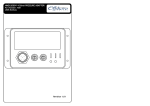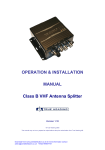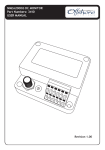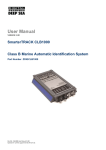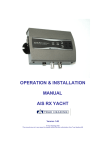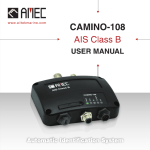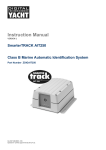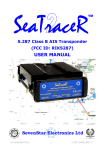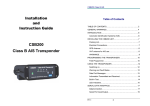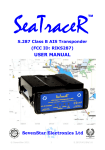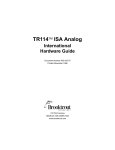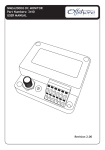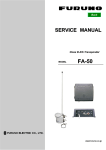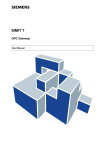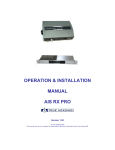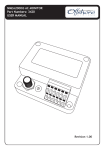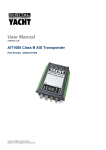Download AIS CTRX GRAPHENE & GRAPHENE+ Manual v1.4E
Transcript
OPERATION & INSTALLATION MANUAL AIS CTRX GRAPHENE Class B AIS Transponder Version 1.4E © True Heading 2013 The manual may not in any aspect be copied without the prior authorization from True Heading AB. AIS CTRX GRAPHENE Class B AIS Transponder Manual TABLE OF CONTENTS TABLE OF CONTENTS ............................................................................................. 2 REVISION .................................................................................................................. 4 INTRODUCTION ........................................................................................................ 5 GLOSSARY ................................................................................................................ 6 CONDITIONS ............................................................................................................. 8 WARRANTY ............................................................................................................... 9 General .................................................................................................................... 9 Warranty conditions ................................................................................................. 9 Warranty procedures ............................................................................................... 9 Other issues ............................................................................................................ 9 SUPPORT ................................................................................................................ 10 GENERAL NOTICE .................................................................................................. 11 LICENSING .............................................................................................................. 12 INFORMATION ABOUT AIS .................................................................................... 13 General .................................................................................................................. 13 Short technical description of AIS .......................................................................... 14 Limitations with AIS ............................................................................................... 15 PRODUCT SPECIFICATION ................................................................................... 16 Declaration of Conformity ...................................................................................... 17 Getting started. ...................................................................................................... 18 INSTALLATION ........................................................................................................ 20 HOW TO PROGRAM THE AIS CTRX GRAPHENE ................................................. 28 SOME FREQUENTLY ASKED QUESTIONS ........................................................... 36 NOTES ..................................................................................................................... 38 Fixing Template ..................................................................................................... 39 APPENDIX A ANTENNAS AND ANTENNA MOUNTING ...................................... 40 GPS Antenna......................................................................................................... 40 VHF antenna for AIS use ....................................................................................... 40 WARNINGS ........................................................................................................... 40 1.4E 2 CTRX GRAPHENE Manual AIS CTRX GRAPHENE Class B AIS Transponder Manual APPENDIX B CTRX GRAPHENE NMEA 2000 PGN LIST .................................... 42 1.4E 3 CTRX GRAPHENE Manual AIS CTRX GRAPHENE Class B AIS Transponder Manual REVISION Version Date Responsible Approved Changes 1.0PE 2012-12-14 Anders Bergström Nils Willart Preliminary release 1.1PE 2013-03-08 Nils Willart Update 1.2PE 2013-04-09 Nils Willart Editorial 1.3PE - - 1.4E 2013-05-21 Nils Willart 1.4E - 4 Intermediate, not used PGN list added CTRX GRAPHENE Manual AIS CTRX GRAPHENE Class B AIS Transponder Manual INTRODUCTION We would like to thank you for choosing True Heading AB as supplier of your AIS Class B Transponder. The AIS CTRX GRAPHENE is a high quality AIS Class B Transponder using the latest technology. AIS CTRX GRAPHENE makes it possible to receive information from ships, buoys, lighthouses, SAR helicopters, Coastguard units, Pilot boats, Weather station etc. and to send information about your own ship to others that are equipped with Automatic Identification System (AIS) transponders or receivers. SEE AND BE SEEN It is today, according to the IMO SOLAS regulation a requirement for all ships above 300 GT to carry AIS. This means that a large number of ships and other types of navigational information providers will be seen by your AIS CTRX GRAPHENE and contribute to enhanced safety in your navigation. Picture 1 Real traffic scenario between Sweden and Bornholm (Denmark) It is of utmost importance that you read this manual before you start to install and use your AIS CTRX GRAPHENE. 1.4E 5 CTRX GRAPHENE Manual AIS CTRX GRAPHENE Class B AIS Transponder Manual GLOSSARY ACA (AIS) Regional Assignment Channel Assignment Message ACK Acknowledgement ACS (AIS) Channel management information source messages AFSK Audio frequency-shift keying ALR (AIS) Alarm Message A to N Aid to Navigation AIS Automatic Identification System ATC Air Traffic Control BIIT Built In Integrity Testing BNC Bayonet fitting type RF connector CSTDMA Carrier Sense Time Division Multiple Access COG Course over Ground CR Carriage Return CS Carrier Sense CSTDMA Carrier Sense TDMA DC Direct Current DGNSS Differential Global Navigation Satellite System DGPS Differential Global Positioning System DSC Digital Selective calling ETA Estimated Time of Arrival GALILEO European equivalent to GPS GLONASS Global Navigation Satellite System GNSS Global Navigation Satellite System GMSK Gaussian Minimum Shift Keying GPS Global Positioning Satellite / System HF High Frequency IMO International Maritime Organization IEC International Electrotechnical Commission LED Light Emitting Diode LF Line Feed LNA Low-noise amplifier MF Medium Frequency MKD Minimum Keypad and Display MMSI Maritime Mobile Service Identity MPE Maximum Permissible Exposure NM Nautical Mile = 1852 m NMEA National Marine Electronics Association PC Personal Computer 1.4E 6 CTRX GRAPHENE Manual AIS CTRX GRAPHENE Class B AIS Transponder Manual PI Presentation Interface RF Radio Frequency RTCM Radio Technical Commission for Maritime Services Commission RX Receive or Receiver RFI Radio frequency interference SAR Specific Absorption Rate SELV Separated Extra Low Voltage SMA Swedish Maritime Administration SMS Short Message System SOG Speed over Ground SOLAS Safety Of Life At Sea SOTDMA Self Organized Time Division Multiple Access. SRM Safety Related Message SRT Software Radio Technology TDMA Time-division Multiple Access TNC Threaded type BNC connector TX Transmit or transmitter UTC Universal Time Co-ordinated VDM (AIS) VHF Data Link Messages VDO (AIS) VHF data link own vessel messages VHF Very High Frequency VTS Vessel Traffic Services (Like ATC but for ships) VSWR Voltage Standing Wave Ratio 1.4E 7 CTRX GRAPHENE Manual AIS CTRX GRAPHENE Class B AIS Transponder Manual CONDITIONS Before you start using the AIS CTRX GRAPHENE product from True Heading AB it is important that you read and fully understand the installation manual and its instructions. You should only proceed with the installation if you are confident that you will be able to do so. True Heading AB cannot be held liable for any injury or damage caused by, during or because of the installation of AIS CTRX GRAPHENE. The AIS CTRX GRAPHENE is used at your own risk and it shall be remembered that AIS and GPS data depends on the full co-operation of other users and systems. AIS CTRX GRAPHENE is a navigation aid and works in co-operation with other similar systems like e.g. radar, optical lookout etc. The AIS CTRX GRAPHENE installation should be inspected from time to time and checked on its operational quality frequently by the user. Remember that navigation and life at sea always requires proper seamanship and that the AIS CTRX GRAPHENE is not a replacement for such qualities. NOT ALL VESSELS CARRY AIS. IT IS THEREFORE IMPORTANT TO KEEP PROPER LOOKOUT AT ALL TIMES AND TO USE ALL AVAILABLE MEANS TO AVOID COLLISIONS AND ACCIDENTS. GPS MAY FROM TIME TO TIME INCLUDE ERRORS: THEREFORE, THE POSITION RECEIVED FROM THE GPS BUILT IN TO AIS CTRX GRAPHENE SHALL ALWAYS BE VERIFED WITH OTHER AVAILABLE MEANS. 1.4E 8 CTRX GRAPHENE Manual AIS CTRX GRAPHENE Class B AIS Transponder Manual WARRANTY General AIS CTRX GRAPHENE is developed and manufactured to meet high technical requirements and user demands. If installed correctly and with regular maintenance your AIS CTRX GRAPHENE should provide you with several years of operation and a very useful product. For further information provided in the manual and in this information sheet please consult the place where you purchased the AIS CTRX GRAPHENE or direct to our support. Warranty conditions - The warranty belongs to the person that purchased the product and cannot be handed over to a third party or person. - The warranty is not valid if serial number is missing, seals broken or if the AIS CTRX GRAPHENE has been incorrect installed. Neither is the warranty valid if instructions for connection have not been followed, faults caused by wrong usage, own made modifications or service made from none authorized service stations. - True Heading AB acknowledges that AIS CTRX GRAPHENE at delivery has been controlled and found operational. - True Heading AB agrees to repair or replace any faulty unit without any cost according to the conditions set forth during a period of two (2) years from day of purchase. - The warranty includes replacement or repair of faulty unit due to error in components or errors in relation to the production of the product. - The warranty covers costs for spares, labor, and return shipment. It does not include shipment from to the repair facility. - True Heading AB will never be liable under the warranty conditions for incorrect use, misuse, and incidental, indirect or consequential damages of the AIS CTRX GRAPHENE. - Proof of purchase is required for any warranty claim of the AIS CTRX GRAPHENE. Warranty procedures True Heading AB repairs and replaces faulty parts or units. The customer is responsible for transport of the defect part or unit to True Heading or its retailer. Warranty claims shall be made to the place where AIS CTRX GRAPHENE was purchased or direct to True Heading AB through mail, fax or e-mail to our support department. Other issues Proper seamanship and common sense is applicable when using AIS CTRX GRAPHENE and the products shall only be seen as a navaid. True Heading AB keeps the right to change the specification of the product without prior notice. IF YOU ARE NOT ABLE TO ACCEPT THE TERMS ABOVE, PLEASE RETURN THE AIS CTRX GRAPHENE TO YOUR RETAILER FOR FULL CREDIT BEFORE OPENED AND USED. 1.4E 9 CTRX GRAPHENE Manual AIS CTRX GRAPHENE Class B AIS Transponder Manual SUPPORT If you need support, please contact the closest reseller or the location where you acquired the product. The manufacturer will only provide support direct if these procedures are followed. The support case has to be registered properly through our webpage at www.trueheading.se . In order to ensure receipt of important information and to protect your guarantee you can register your AIS CTRX GRAPHENE purchase at True Heading AB by sending an e-mail to [email protected] where you indicate series numbers, purchase dates, your name, address and where you bought your equipment. In accordance with our policy to always offer development and enhancements of our products, and future versions of AIS CTRX GRAPHENE may differ somewhat from this manual. Updated versions of the manual are always available for download at our homepage www.trueheading.se . The information in this manual is subject to change without prior notice or information thereof. © 2012 True Heading AB 1.4E 10 CTRX GRAPHENE Manual AIS CTRX GRAPHENE Class B AIS Transponder Manual GENERAL NOTICE The Automatic Identification System (AIS) unit mostly utilise a Global Navigation Satellite System (GNSS) system such as e.g. GPS or GLONASS to determine position. The accuracy of these systems is variable and can be affected by factors such as the positioning of the antenna, the number of satellites available to determine a position and for how long satellite information has been received. It is desirable as often as possible to verify both your vessel’s AIS derived position data and other vessels AIS derived position data with visual or radar based observations. The compass safe distance of this unit is 0.5m or greater for 0.3° deviation. 1.4E 11 CTRX GRAPHENE Manual AIS CTRX GRAPHENE Class B AIS Transponder Manual LICENSING IMPORTANT: In most countries the operation of an AIS unit is included under the vessels marine VHF radio licence provisions. The vessel on to which the AIS unit is to be installed must therefore possess a valid VHF radiotelephone licence which lists the AIS system and the vessel Call Sign and MMSI number. Please contact the relevant authority in your country for more information. In accordance with our policy of continuous development and product improvement the AIS CTRX GRAPHENE hardware and/or software may be upgraded from time to time and future versions of the AIS CTRX GRAPHENE may therefore not correspond exactly with this manual. When necessary upgrades to the product are made, these will be accompanied by updates or addenda to this manual. Please take time to read this manual carefully to understand its contents fully so that you can install and operate your AIS system correctly. Information contained in this manual is liable to change without notice. True Heading AB disclaims any liability for consequences arising from omissions or inaccuracies in this manual and any other documentation provided with this product. © 2013 True Heading AB 1.4E 12 CTRX GRAPHENE Manual AIS CTRX GRAPHENE Class B AIS Transponder Manual INFORMATION ABOUT AIS General AIS (Automatic Identification System) is the name of a system that makes it possible for ships to identify other ships and to monitor ship movements. The reason for implementing the AIS system is for the mariner to obtain more information about ships in the vicinity than what radar is able to provide. AIS gives e.g. information about a ships identity (name, call sign, IMO number and MMSI), size this even for ships behind Island or bends that radar cannot detect. AIS is used to enhance safety for life at sea, improve safety and efficiency in navigation and protect the marine environment. AIS-information transmitted from a ship contains of three (3) different main types: - Static data that was programmed into the AIS equipment at installation and it only needs to be changed if the ship changes its name, flag or undergoes a major refit where size or ship type is changed; - Dynamic data contains information that automatically is updated from ship sensors like the heading from the Gyro, Position and speed from GNSS equipment. Also navigational status belongs to the group of dynamic data but is updated manually by the crew; and - Voyage related data that manually is updated by the crew along the voyage. From the start AIS sometimes also was referred to as UAIS or as the 4S transponder system that meant Ship to Ship and Ship to Shore. IMO adopted 1998 a performance standard for AIS within the SOLAS requirement that described in general how AIS should work. Below follows a brief description of the main requirements for AIS from the performance standard: Automatically provide information to AIS land stations, other ships and airborne units e.g. SAR helicopters about the ships identity, Type of ship, Position, Course, Speed, Navigational status (e.g. under way using engine, at anchor) and other safety related information of importance. Be able to receive the same type of information from other ships. Be able to monitor and track other ships. Exchange information with land based AIS systems. AIS is an automatic system that continuously and simultaneously transmits on two channels in the maritime VHF frequency band. AIS can handle several reports in a rapid consecutive flow. To accomplish this AIS uses a technique called Self Organized Time Division Multiple Access (SOTDMA) that guarantees high transmission safety and operational robustness. AIS also allows for other types of information from e.g. sensors like Gyro, GPS and echo sounders etc. to be transmitted automatically. Important areas where AIS is used are: 1.4E Information exchange between ships within VHF range (normally 20-30 NM) to enhance safety at sea and to improve situation awareness. 13 CTRX GRAPHENE Manual AIS CTRX GRAPHENE Class B AIS Transponder Manual Information exchange between ships and AIS land stations as e.g. a VTS that controls and monitors maritime traffic in an area. Automatic reporting in areas with mandatory reporting of different kinds. Exchange of safety related information between ships and between ships and land stations. Services like e.g. meteorological information in real-time from areas of importance, identity and position of floating and fixed aids to navigation to improve identification and navigation. How AIS Works The marine Automatic Identification System (AIS) is a location and vessel information reporting system. It allows vessels equipped with AIS to automatically and dynamically share and regularly update their position, speed, course and other information such as vessel identity with similarly equipped craft. Position is derived from a Global Navigation Satellite System (GNSS) network and communication between vessels is by Very High Frequency (VHF) digital transmissions. A sophisticated and automatic method of time sharing the radio channel is used to ensure that even where a large number of vessels are in one location blocking of individual transmissions is minimised, any degradation of the expected position reporting interval is indicated to the user and even if the unit suffers extreme channel overload conditions it will always recover to normal operation. AIS Classes There are two classes of AIS units fitted to vessels, Class A and Class B. In addition AIS base stations may be employed by the Coastguard, port authorities and other authorised bodies. AIS units acting as aids to navigation (A to N) can also be fitted to fixed and floating navigation markers such as channel markers and buoys. Class A units are a mandatory fit under the safety of life at sea (SOLAS) convention to vessels above 300 gross tons or which carry more than 11 passengers in International waters. Many other commercial vessels and some leisure craft also fit Class A units. Class B units are currently not a mandatory fit but authorities in several parts of the world are considering this. Class B units are designed for fitting in vessels which do not fall into the mandatory Class A fit category. The AIS CTRX GRAPHENE is a Class B unit Position Information Source As noted above the marine AIS system uses position information derived from networks such as the Global Positioning Satellite (GPS) or the Global Navigation Satellite System (GLONASS) in order to determine the location of the AIS unit and thus the vessel to which it is fitted. Short technical description of AIS AIS operates primarily on two dedicated VHF-frequencies (AIS1 – 161,975 MHz and AIS2 – 162,025 MHz). In areas where these two channels are not available, AIS can automatically change to other alternatively available frequencies. AIS uses two VHF radio channels, where the information is transmitted in short data packages or slots in predefined and synchronized time frames. The dynamic information (position, speed, heading etc) is transmitted in intervals from 2s up to 10s depending on the manoeuvres of the transmitting ship were the AIS is mounted. Static and voyage related information (type of ship, size, cargo, destination etc.) is transmitted every sixth minute or upon request from other units. Position, course and speed 1.4E 14 CTRX GRAPHENE Manual AIS CTRX GRAPHENE Class B AIS Transponder Manual normally are collected from the same sensor systems that provides the same information used in the navigation e.g. in radars or ECDIS and this is normally based on GPS or DGPS. All ships within VHF coverage will be able to receive AIS data and competent authorities that have installed networks with coastal AIS coverage can receive the information. The capacity for the ships to report is defined by the IMO performance standard to a minimum of 2000 data packages or slots per minute (see picture 2). ITU (Technical Standard for the Universal AIS) has been kind to double this and has provided AIS with 4500 data packages or slots per minute. The transmission is based on the (SO)TDMA (Self-organized Time Division Multiple Access) technique, that allows the system to overload with 400 till 500 % and still give almost a 100 % message throughput between ships that are closer to each other than 8 to 20 nautical miles. In such case the system overloads targets far away will be discriminated in favor of targets close to your own ship. In reality, the system capacity is unlimited and allows for a large number of ships to communicate simultaneously. Picture 2 The principle of AIS technology on the two radio channels. Limitations with AIS You should always be aware that all ship others ships and in particular pleasure crafts, fishing boats, warships and some coastal stations and VTS not will be equipped with AIS. Ships that have been mandated to carry AIS can also under certain conditions turn of their AIS equipment at the master’s disgrace. Therefore it is important to be aware that the information that AIS provides might not be the full and complete picture of the situation around your ship. Users of AIS must also be aware that transmission of false data can occur and that this will be hazardous not only to your own ship but to other as well. The user is responsible for all data that is entered into the system and for information provided by external sensors. The accuracy of received AIS data is only as good as the information transmitted from the source of information. You should always be aware that wrong configured or calibrated ship sensors (positions-, speed- or heading sensors) could lead to that wrong information will be transmitted. Dangerous situations can occur if faulty information is shown on another ship. 1.4E 15 CTRX GRAPHENE Manual AIS CTRX GRAPHENE Class B AIS Transponder Manual PRODUCT SPECIFICATION Dimensions: 210 x 144 x 50 mm (L x W x H) Weight: 0,45 kg GRAPHENE, 0,5 kg GRAPHENE+ Power: DC 12-24V (min. 10V, max. 32V) Average power consumption 4W (GRAPHENE) Average power consumption 4.5 W (GRAPHENE+) 350 mA@12 VDC (receiving) Peak current rating: 1.2A @ 12VDC (transmitting) GPS Receiver (AIS Internal): IEC 61108-1 compliant 50 channels Data Interfaces: USB NMEA 2000 LEN (Load Equivalence Number) = 1 NMEA 0183, RS422 38400 baud Connectors: VHF Antenna connector = BNC (Female) GPS Antenna connector = TNC (Female) USB B serial data (USB mini connector) Combined NMEA 0183/DC power connector NMEA2000 connector VHF Radio = FME (Male) -GRAPHENE+ only VHF Transceiver: 1 Transmitter, 2 Receivers Frequency: 156.025 to 162.025 MHz Receiver sensitivity: <- 110dBm @ 20% PER RF Output Power: 2 W (50Ω) Channel Bandwidth: 25 kHz Data Bit rate: 9600 b/s ± 50 ppm (GMSK) AIS 1200 b/s ± 30 ppm (FSK) DSC Environmental: IEC 60945, Operating Temperature: -15ºC to +55ºC IEC 62287, Section 5, Cat c) exposed to the weather Compass safe distance: 0.5m or more for 0.3° deviation. LED indicators: POWER STATUS TX STAT ERROS VHF TX SILENT- 1.4E 16 Green Green Yellow Red Yellow Blue CTRX GRAPHENE Manual AIS CTRX GRAPHENE Class B AIS Transponder Manual Standards This product complies with all the necessary standards under the European R&TTE directive for Article 3.1(a), 3.1(b), 3.2 and 3.3(e). The following standards have been followed in pursuance of this: IEC62287-1, Ed2: 2006-03 Maritime navigation and radio communication equipment and systems – Class B ship borne equipment of the automatic identification system (AIS) – Part 1: Carrier-sense time division multiple access (CSTDMA) techniques IEC60945, Ed4: 2002-08 Maritime navigation and radio communication equipment and systems – General requirements – Methods of testing and required test results IEC61162-1, Ed2: Maritime navigation and radio communication equipment and systems – Digital interfaces – Part 1: Single talker and multiple listeners IEC61108-1: GLOBAL NAVIGATION SATELLITE SYSTEMS (GNSS) – Part 1: Global positioning system (GPS) -Receiver equipment - Performance standards, methods of testing and required test results EN 301 843-1 v2.1: Electromagnetic compatibility and Radio spectrum Matters (ERM); Electromagnetic Compatibility (EMC) standard for marine radio equipment and services; Part 1: Common technical requirements EN 50383: 2002 Basic standard for calculation and measurement of electromagnetic field strength and SAR related to human exposure from radio base stations and fixed terminal stations for wireless telecommunications system (110MHz – 40GHz) EN60950-1:2002 Information technology equipment – Safety – Part 1: General requirements NMEA2000 Edition 2.20 Declaration of Conformity True Heading AB declares that this product is in compliance with the essential requirements and other provisions of the R&TTE directive 1995/5/EC. The product carries the CE mark, notified body number and alert symbol as required by the R&TTE directive This True Heading product can be used in the following European Community and EFTA Contries: AT BG BE CY CZ EE FI FR DE GR HU IE IT LV LT LU MT NL PL PT RO SK SL ES SE GB IS LI DK NO CH 1.4E 17 CTRX GRAPHENE Manual AIS CTRX GRAPHENE Class B AIS Transponder Manual Getting started. Before AIS CTRX GRAPHENE is installed, you should check that you have all the equipment you need for the installation and that nothing is missing from your delivery. The AIS CTRX GRAPHENE comes in two versions the GRAPHENE and the GRAPHENE+ version. The plus version also contains a built in antenna splitter making it possible to use the same VHF antenna for both the AIS and the VHF radio. AIS CTRX GRAPHENE comes with the following parts: 1 AIS CTRX GRAPHENE Class B Transponder P/N 0012-001-000 1 Data and DC cable (1 m) P/N 0012-770-000 1 USB cable 1 m P/N 0012-980-000 1 BNC to UHF adapter P/N 0012-989-000 1 CD incl. manual, set up software and AIS information P/N 0012-972-000 AIS CTRX GRAPHENE + comes with the following parts: 1 AIS CTRX GRAPHENE Class B Transponder P/N 0012-002-000 1 Data and DC cable (1 m) P/N 0012-770-000 1 USB cable 1 m P/N 0012-980-000 1 BNC to UHF adapter P/N 0012-989-000 1 Cable (2 m) AIS to VHF with connectors P/N 0010-980-000 1 CD incl. manual, set up software and AIS information P/N 0012-972-000 The following may be needed to finish your installation but is not included: 1 VHF marine band antenna with cable and UHF or BNC type coaxial connector. 1 GPS antenna (active antenna, built-in LNA, 20dB gain min., 5VDC) with cable and TNC coaxial connector 2 3A Fuse with fuse holder 1 DC cable, for the DC power installation 4 Mounting screws 1 Installation materials such as mounts for the antennas, cable ties, screws, connection blocks etc. 1.4E 18 CTRX GRAPHENE Manual AIS CTRX GRAPHENE Class B AIS Transponder Manual Before you begin the installation, you should decide on where you want to place your AIS CTRX GRAPHENE unit. Note the following: Place the transponder in such a way that you will be able to see the LED’s on the front. This will make it easy to monitor the functions and make sure that the unit is working properly. The transponder should be installed in a place where the length of the antenna cables can be kept as short as possible, but also where DC power and access to other equipment you would want to connect the AIS to is conveniently available. AIS CTRX GRAPHENE has 3 data ports. 2 of them are preferably used for the connection to a plotter (the NMEA0183/RS422 or the NMEA 2000 port). A USB port (mini type) is available for connection to a PC. This is used for the configuration of the unit as well as maintenance or use with a PC navigation solution. If you are installing the AIS CTRX GRAPHENE+ version or using a Class B VHF splitter with the standard CTRX Graphene it is recommended that you connect the DC leads it to the same power source as your VHF. There are antennas available specifically made for use with AIS equipment but any standard type marine band VHF antenna will work. Place your VHF antenna as high as possible but at least 2.5-3 m above the water surface. If you are installing a separate AIS antenna you should make sure that it is separated as much as possible from other VHF antennas to avoid interference. GPS antennas should be installed in such a way that the antenna top surface has a free and unobstructed view of the horizon. Make sure that the antenna is not placed nearby metal objects in order to minimize reflections of the received signal. GPS antennas should not be placed in the vicinity of high power HF or satellite communications equipment. 1.4E 19 CTRX GRAPHENE Manual AIS CTRX GRAPHENE Class B AIS Transponder Manual INSTALLATION Once you have unpacked the box and checked that your delivery is complete, proceed with the installation as follows: Figure 5 AIS CTRX GRAPHENE + with its antennas and data/DC connectors The 12 pole multi-pin connector mounted on the transponder has the following configuration of the pins: Pin Signal Color marking 1 Signal ground BROWN 2 Power supply Voltage GND (-) BLUE 3 SILENT LED (Blue) WHITE 4 Signal ground GREEN 5 NMEA 0183/RS-422 TX B (-) YELLOW 6 NMEA 0183/RS-422 TX A (+) GREY 7 NMEA 0183/RS-422 RX A (+) PINK 8 Power supply Voltage (+) RED 9 Power supply Voltage GND (-) BLACK 10 Power supply Voltage (+) ORANGE 11 External SILENT switch PURPLE 12 NMEA 0183/RS-422 RX B (-) LIGHT GREEN Table 1. Data/DC connector configuration 1.4E 20 CTRX GRAPHENE Manual AIS CTRX GRAPHENE Class B AIS Transponder Manual The transponder is secured to the bulkhead or deck by means of four screws. A template for the fixing of the screws is supplied in the box in the shape of a cardboard divider sheet. The transponder should be installed so that the six LEDs on the front panel are readily visible for monitoring of the AIS CTRX GRAPHENE functionality. Furthermore, the transponder may also be placed for easy access of the "S" –marked button, which is used to switch on and off the unit in “silent mode”. Silent mode turns off the transmitter and places the transponder in in receive- only mode. A remote switch and LED indicator can be connected to the transponder through the DC/DATA cable as shown in table 1. A USB connector is also available. For best performance and an easy installation a suitable place should be found were the installations can provide: 1. Short cable-runs for the VHF and GPS antenna. 2. Easy access to DC power. 3. Access to other equipment to which you would connect the transponder to. To avoid interference from other equipment on board such as generators, compressors or electrical panels the unit should not be installed together or close to such equipment. The accompanying installation software provides a diagnostic program which can be useful to diagnose a situation where the transponder is experiencing interference. Read more about this in the ”Diagnostics” section in the chapter on programming AIS CTRX GRAPHENE. To ensure that best performance is obtained it is important to choose good antenna cables. For shorter lengths RG58C/U is sufficient. For cable lengths exceeding 10 m, a low loss cables should be used, such as type RG213, RG214, or LM400, depending on length. It is also important to use proper connectors, where crimp type connectors are preferred over soldered connections. Ready-made 10 m lengths of RG58C/U type cable can conveniently be used. Ready-made lengths with FME type connectors are available where adaptors for the different kind of coaxial connectors used can be fitted. In this way an easy-to-assemble cable/connector kit can be put together for a specific installation without any special tools. True Heading can provide ready-made kits, cables and connectors. 1.4E 21 CTRX GRAPHENE Manual AIS CTRX GRAPHENE Class B AIS Transponder Manual Figure 7. CTRX Graphene+: From L to R: NMEA2000 connector, USB-mini connector, Data/DC circular connector, GPS antenna (TNC), VHF antenna (BNC) and VHF radio (FME). Figure 7. CTRX Graphene: From L to R: NMEA2000 connector, USB-mini connector, Data/DC circular connector, GPS antenna (TNC), VHF antenna (BNC). After installation of the antennas the AIS CTRX GRAPHENE should be connected to the application where the AIS data from the transponder will be used. AIS CTRX GRAPHENE has three data ports, 1 NMEA2000, 1 USB and 1 NMEA 0183 to choose from. 1.4E 22 CTRX GRAPHENE Manual AIS CTRX GRAPHENE Class B AIS Transponder Manual CONNECTION, GENERAL OVERVIEW To VHF radio (Graphene+ only) NMEA2000* USB to computer VHF antenna (BNC) GPS antenna (TNC) GREY DC/Data cable (NMEA OUT Tx-A) YELLOW (NMEA OUT Tx-B) To NMEA0183 nav display, e.g. plotter PURPLE GREEN To external Silent button WHITE GREEN To external LED for Silent button RED ORANGE 9-32 VDC Power supply BLACK BLUE 1.4E 23 0V DC CTRX GRAPHENE Manual AIS CTRX GRAPHENE Class B AIS Transponder Manual ANTENNA CONNECTIONS VHF-antenna E.g. AC Marine CX4 GPS-antenna (RV76) CTRX Graphene Existing VHF radio 2m RG-58 cable w/connectors FME & UHF. Existing VHF antenna cable in your boat Cable, 5m, RG-58, attached to the GPS antenna CTRX Graphene+ 1.4E 24 CTRX GRAPHENE Manual AIS CTRX GRAPHENE Class B AIS Transponder Manual CONNECTION TO AN NMEA2000 NETWORK The picture shows the CTRX Graphene+ NMEA2000* Connection RED ORANGE BLACK BLUE 9-32 VDC (+) 0 VDC (-) NMEA2000 Drop cable Must not be longer than 6m NMEA2000 End resistor 120 Ohm NMEA2000 T-connection NMEA2000 End resistor 120 Ohm NMEA2000 Power Tap NMEA2000 Backbone 9-16 VDC (+) 0 VDC (-) NOTE: The transponder must be connected to an external power source when connected to an NMEA2000 network. Even though some NMEA2000 devices can operate on the bus power, the transponder current consumption is higher than the maximum allowed and subsequently must use external power. LEN=1 (LEN= Load Equivalence Number) 1.4E 25 CTRX GRAPHENE Manual AIS CTRX GRAPHENE Class B AIS Transponder Manual CONNECTION TO THE DC POWER SUPPLY Now, the connection to the DC power supply is all that's left. The AIS CTRX GRAPHENE can be connected to any DC power supply providing between 12V to 24V DC. The lower limit is 10V. Should the supply voltage go below 10V the ERROR LED on the front panel will light up and the unit cease to transmit. The upper limit is 32VDC. This is the maximum allowable voltage. If the upper voltage limit is exceeded severe damage will be made to the transponder. The DC supply point should be chosen with care. The recommended source should be the same as the VHF radio and/or other navigational equipment. Even though the source may be protected with a circuit breaker the transponder must have its own fuse protection. The recommendation is to use two 3A fuses (one on the positive lead and one on the negative lead) to provide protection for the transponder. Note that the negative lead (-) on the transponder is connected to the same part as the ground on the VHF and GPS antenna connector. This means that if either antenna (VHF or GPS) is bolted to a metal structure on board will connect this to the negative pole of the power supply (battery). If the unit is installed in a vessel with a metal hull it is highly recommended that a galvanic isolated DC/DC converter is connected between the battery and the transponder to prevent galvanic corrosion. NOTE: Be careful not to reverse the polarity of the power supply leads, this may cause severe damage to the transponder. The transponder is supplied with a combined Data/DC power cable. The power supply is connected as follows: RED and ORANGE cable (twisted together) connects to positive (+) BLUE and BLACK cable (twisted together) connects to negative (-) Do not forget the fuses ! 1.4E 26 CTRX GRAPHENE Manual AIS CTRX GRAPHENE Class B AIS Transponder Manual Connection of an external Silent switch with LED indicator DC/DATA Cable PURPLE Single pole, pushbutton switch GREEN WHITE LED (blue color recommended) ORANGE 9-32 VDC RED BLUE 0 VDC BLACK 1.4E 27 CTRX GRAPHENE Manual AIS CTRX GRAPHENE Class B AIS Transponder Manual HOW TO PROGRAM THE AIS CTRX GRAPHENE AIS CTRX GRAPHENE can be programmed with the software proAIS2. The data needed in order to program AIS CTRX GRAPHENE are: MMSI number: Call sign: Vessel name: Type of vessel: GPS ant. position: Table 6 ex.: A= meters B= meters C= meters D= meters 37 Pleasure craft Template to generate the static data for programing The transponder kit includes the proAIS2 software where all settings can be programmed. A valuable diagnostics tool is also available in proAIS2. proAIS2 is developed to run on Windows XP (SP2), Windows Vista and Windows 7 & 8. A version for MacOS is also available on the product CD. 1.4E 28 CTRX GRAPHENE Manual AIS CTRX GRAPHENE Class B AIS Transponder Manual INSTALLATION 1. 2. 3. 4. 5. 6. Insert the installation CD and locate the file ”Setup.exe”. To start the installation double- click on the file icon ”Setup.exe” If required, follow the directions to install MS dotNet framework When the security alert pop-up appears, select ”Install” proAIS2 will install and launch automatically. A proAIS2 icon will be created and appear in the Start Menu folder. Removal of ProAIS from the computer The proAIS software can be removed at any time by using the ”Add or Remove Programs” feature in the Control Panel (may differ depending on OS) Connect to your AIS CTRX GRAPHENE with proAIS When using the proAIS2 program with the transponder, the AIS CTRX GRAPHENE should be connected using the supplied USB cable. It will be powered from the USB cable during programming but cannot operate normally unless connected to a 12V or 24V DC power supply. After starting the proAIS 2 application you should first select the communication port to which the transponder is connected. Select the port indicated as AIS transponder. If no port is shown the PC may need to have an updated driver for the USB port. Connect to the internet, disconnect the transponder USB cable and then connect it again. Windows will automatically search for a driver. When installed the port should be available to select. Then click on the Connect- button. The computer connects to the transponder and the data fields to be programmed will be appear on the Configuration page. If the USB driver fails to install automatically, a USB driver is provided on the CD. Run the set-up in the USB driver folder to install the driver. 1.4E 29 CTRX GRAPHENE Manual AIS CTRX GRAPHENE Class B AIS Transponder Manual Figure 15 Connection of PC to AIS CTRX GRAPHENE takes place via choice of the correct port. Normally the correct port will occur as the first choice stating AIS Class B AIS. When connected to proAIS 2, the static data is presented on the Configuration page. If the fields are empty, the transponder is un-programmed. Type in Ship’s Name (use ONLY A-Z and –), Call Sign and MMSI number. Select Vessel type, the type of vessel on which the transponder is installed on. We recommend that all types of leisure craft is set as 37 = Vessel -Pleasure craft. Ships dimensions are determined by the position of the GPS antenna. The length of the vessel is set by the distance measured from fore to the GPS antenna and from aft to GPS antenna. The beam is measured as the distance from starboard to the GPS antenna and from port to the GPS antenna. All distances are in meters. Even the distance upwards to the nearest meter. When finished click on Write Configuration. Follow the instruction on the screen. Note that the MMSI number can only be programmed ONCE! If the transponder has been programmed with incorrect MMSI data True Heading must be contacted. Before data is stored you will be prompted to make sure that the data is correct before you can proceed to write the data permanently. This is the last chance to correct any errors, so make absolutely sure that MMSI, Name and Call sign are correctly entered in their respective fields before you press the button. In the Configuration field you can also select which type of GPS data that should be output on the data port. The default set message is the NMEA sentence RMC (Recommended Minimum speCific GNSS data) which contains the essential position, course, speed and time data. GPS data. Enable SBAS (EGNOS or WAAS) selects if DGNSS corrections is to be used or not. The baud rate of the NMEA data port is also 1.4E 30 CTRX GRAPHENE Manual AIS CTRX GRAPHENE Class B AIS Transponder Manual changeable. The default settings (38400 baud) is set for AIS and should NOT be changed. The next menu is GNSS status which is a valuable tool for monitoring the built-in GPS receiver function. This tool can conveniently be used during installation to check that the GPS antenna has been placed in a good location for reception and that cables and connections are properly put together and not damaged. When the transponder receives signals from the satellites a vertical bar will appear representing the received satellite. The bar will change colour depending on the status of the satellite. When the receiver is locked to a satellite the bar will change from blue to green, indicating that the satellite is used for navigation. If SBAS is used the satellites involved in tracking the SBAS data will show up in yellow. The reception quality is displayed as a C/N value (carrier to noise), which means that the higher the value, the higher the signal quality is. A mean value for a reasonable reception quality should be not less than 30 dBHz. Figure 16 AIS CTRX GRAPHENE GNSS Status field showing satellites being used as well as not being used plus DGNSS satellites using SBAS. Selecting the tab Other Vessels” provide you with an easy way to check that your AIS CTRX GRAPHENE receives data from other AIS transponders. By clicking on each column, the table can be arranged in falling or increasing order depending on the column of interest. 1.4E 31 CTRX GRAPHENE Manual AIS CTRX GRAPHENE Class B AIS Transponder Manual Figure 17 In the [Other Vessels] field, information is present about all AIS units that can be seen by the connected AIS CTRX GRAPHENE transponder. The next menu is Diagnostics. Here you will find several functions and tools to check that the AIS CTRX GRAPHENE transponder works properly and facilities to monitor functionality and performance during and after installation. In the window Checklist, you can check the main functions of the transponder. This includes Programming (Transponder MMSI valid), GPS functionality (GPS Position Fix), transmission (AIS has transmitted a position report), antenna function (AIS antenna), reception (AIS has received a report) and power supply (Power supply OK). Once the items have a green tick the function is checked and validated. The Internal data window shows the version numbers for firmware and bootcode, as well as the product code and internal serial number. The serial number is the same as on the bottom label and should be referred to should it be necessary to contact True Heading for support. Also the VSWR value (antenna matching factor) is shown here as well as the power supply input voltage. The Status window show the status of the LED’s on the front panel. Normal operation should have the green LED light. Once in a while, depending on the operational situation (AIS traffic load) the status may change to yellow, which means that the transponder has not been able to transmit during the last transmission period. Once the units have transmitted the LED lights will go back to green. In the Statistics window received and transmitted messages on the two channels will be shown. The values are accumulated from the time the transponder was connected up to proAIS program. The values will be reset as soon as the connection is disconnected. 1.4E 32 CTRX GRAPHENE Manual AIS CTRX GRAPHENE Class B AIS Transponder Manual Figure 18 AIS CTRX GRAPHENE Diagnostics field provides good information about the transponder's status and the software version. Before the AIS CTRX GRAPHENE has been programmed, both the yellow and red LED’s will light, indicating that the unit is not programmed (no valid MMSI number). This is shown both on the transponder and on the status panel in proAIS2. The most common fault is however, that the transponder has no valid MMSI, so always check this first. The red ERROR LED can also have the following meaning: • The transmitter is stuck in transmit (transmitted longer than 1 s). • The GPS has not started to navigate after 30 minutes • Excessive VSWR value (> 3:1) (faulty antenna or cable problem). • Background noise is too high which prevents the transponder from transmitting. • Faulty transmitter (no power output) The yellow LED will light to indicate a change in the operating status. The situation has called for the transmitter to stop transmitting. The yellow TX TIMEOUT LED can mean the following conditions: • The transponder GPS has not started to navigate or does not navigate which means that the transponder cannot transmit as the position data is not valid. • The transponder cannot transmit because the channel is occupied by another transponder transmitting 1.4E 33 CTRX GRAPHENE Manual AIS CTRX GRAPHENE Class B AIS Transponder Manual The blue SILENT LED will light when AIS CTRX GRAPHENE is set in silent mode, which turns off the transmitter. This puts the transponder in receive-only mode. This is referred to as ”SILENT MODE”. The transponder can be switched to SILENT mode by either holding the “S” button on the front panel down for 3 seconds or by using an external switch (see page 21 for wiring instructions) To switch off the SILENT mode hold the “S” button down for 3 seconds. The blue LED will turn off after approximately 1 second. A third way to switch the unit to SILENT MODE is to use the software button (marked Silent Mode) in proAIS2 status window were the function can be remotely switched on and off. NOTE that this is a special function in proAIS2 and that it is separate from the hardware control to set the silent mode with the switch. The green STATUS LED means that everything is OK. 1.4E 34 CTRX GRAPHENE Manual AIS CTRX GRAPHENE Class B AIS Transponder Manual The last page in proAIS is Serial data. This window offers the more experienced installer a valuable tool to monitor the data output from the transponder. Data is output in NMEA0183 format. Received data will appear as !AIVDM strings, transmitted data as !AIVDO and GPS data as $GPRMC. The field Enter commands below is used for input data to the transponder. This field is only used for diagnostics, service functions etc. The data shown in the window can be logged and recorded in file format for later recovery and analysis. Figure 19 1.4E In the field Serial data the data the transponder transmits is displayed on its port and from this data, important information can show that the transponder functions correctly. 35 CTRX GRAPHENE Manual AIS CTRX GRAPHENE Class B AIS Transponder Manual SOME FREQUENTLY ASKED QUESTIONS Q: Is it possible to use an existing VHF antenna for my AIS CTRX GRAPHENE+? A: The AIS CTRX GRAPHENE+ has a built-in antenna switch which makes it possible to share the antenna between the transponder and the VHF radio. Sharing the antenna will add some attenuation of the signal in receive mode but during transmission with either the VHF radio or the transponder full power will reach the antenna. The antenna height is extremely important for range, especially on a sailboat where the antenna can be placed on top of the mast. If a separate antenna is used, it should be placed at least 3 m above the water to be able to cover a range of 10 nm. Q: Can an existing GPS antenna be used for my AIS CTRX GRAPHENE, i.e. the one which I already have to my plotter? A: A GPS Signal can also be divided using a signal splitter which often is a more expensive alternative compared to installing a separate antenna for the AIS transponder. With AIS CTRX GRAPHENE and a separate GPS antenna the transponder will provide a backup source for position, speed and course, which can be used with the onboard navigational system. Q: What type of GPS and VHF antenna should I use with my AIS CTRX GRAPHENE? A: The antennas should meet the following requirements: The GPS antenna should have the following performance: Antenna type: RHCP, patch or quadrifilar type. Power feed: 5V DC LNA gain: 20 dB (min) Impedance: 50 ohm Connector type on AIS CTRX GRAPHENE: TNC female The VHF antenna shall have the following performance: Antenna type: Vertical radiator (dipole) Antenna gain : 0 – 3 dBd Impedance: 50 ohm There are specially tuned AIS antennas available today which provide better performance because they are tuned to the frequencies used by the AIS transponder. Contact True Heading AB for more information. 1.4E 36 CTRX GRAPHENE Manual AIS CTRX GRAPHENE Class B AIS Transponder Manual Q: Can I connect my AIS CTRX GRAPHENE to my plotter? A: Today there are a number of plotters that can present AIS or that can receive AIS data. Furuno, Garmin, Interphase, Seiwa, Raymarine and VDO now have support for AIS. Several other plotter manufacturers are working on being able to handle AIS data in a near future. For additional information about this, contact your plotter supplier and inquire about the AIS interface. Just as with PC based programs there are large difference between the suppliers in their ability to handle different AIS messages. Weather data messages (message 8) may not appear in some applications. Q: Which sea chart programs can display AIS targets? A: Today, most electronic sea chart programs can display AIS targets. All programs that can handle the NMEA message VDM will be able to make use of the AIS information and display the data on the screen or display. AIS, however consist of a number of messages and different capabilities among the different suppliers are the rule regarding AIS data. Ask your supplier for more information about your system. Special software is also available, such as AIS YACHT from Y-tronic where AIS is presented on a radar-like display. Q: Will AIS CTRX GRAPHENE work with network-type systems on board? A: All networks that can handle NMEA VDM data at 38400 b/s should be able to manage AIS data. Furuno says their Navnet can do this, while Raymarine’s Seatalk and Silva’s Nexus does not. AIS CTRX GRAPHENE is NMEA 2000 approved and should connect with most systems compatible with AIS functionality. Ask your supplier for additional information about your system. 1.4E 37 CTRX GRAPHENE Manual AIS CTRX GRAPHENE Class B AIS Transponder Manual NOTES 1.4E 38 CTRX GRAPHENE Manual AIS CTRX GRAPHENE Class B AIS Transponder Manual Fixing Template NOTE: NOT drawn to scale ! 1.4E Manual 39 CTRX GRAPHENE AIS CTRX GRAPHENE Class B AIS Transponder Manual APPENDIX A ANTENNAS AND ANTENNA MOUNTING GPS Antenna The GPS antenna used must be of the active type (i.e. it should incorporate an LNA) and must be suitable for marine shipboard applications (index of protection, ruggedness, means of mounting, etc.). An antenna should be selected with a gain (in dB) depending on the length of cable between the antenna and the AIS unit; after subtraction of cable and connector losses a minimum total gain of 25 dB should be available at the AIS CTRX GRAPHENE unit GPS antenna connector. The GPS antenna to be used for AIS use must be a dedicated antenna, i.e. not shared with any other GPS receiver. Installation of the GPS antenna is critical for the performance of the built in GPS receiver which is used for timing of the transmitted time slots and for the supply of navigational information should the main navigational GPS fail. We strongly recommend that: 1. The GPS antenna is mounted in an elevated position and free of shadow effect from the ship’s superstructure 2. The GPS antenna has a free view through 360 degrees with a vertical angle of 5 to 90 degrees above the horizon. 3. As the received GPS signal is very sensitive to noise and interference generated by other onboard transmitters, ensure that the GNSS antenna is placed as far away as possible from radar, Inmarsat and Iridium transmitters and ensure the GPS antenna is free from direct view of the radar and the Inmarsat antenna beam. 4. It is also important that the MF/HF and other VHF transmitter antennas are kept as far away as possible from the GNSS antenna. It is good practice never to install a GNSS antenna within a radius of 5 Metres from these antennas. VHF antenna for AIS use The VHF antenna employed for AIS use: Must be a dedicated antenna, i.e. not shared with any other VHF transmitter/receiver. Must be suitable for marine shipboard applications (index of protection, ruggedness, means of mounting, etc.) Should be omni-directional and vertically polarised with unity gain (0 dB) with a bandwidth sufficient to maintain VSWR <1.5 over the frequency range 156 – 163 MHz. As a minimum the 3dB bandwidth must cover the two AIS channels and the DSC Channel. Should be mounted with at least a two metre vertical separation distance from any other VHF antenna used for speech or DCS communication but see also the section “Radio Frequency Exposure Warning” below Should be mounted at least 2-3 metres above sea level for full performance. WARNINGS VHF Antenna Connection Connecting a badly mismatched VHF antenna, leaving the VHF antenna port disconnected, or shorting the VHF antenna port will activate the VSWR alarm, cause the unit to stop sending position reports or cause damage to the transponder. 1.4E Manual 40 CTRX GRAPHENE AIS CTRX GRAPHENE Class B AIS Transponder Manual Radio Frequency Exposure To meet the requirements for Radio Frequency Exposure it is necessary to install the VHF antenna correctly and operate the AIS equipment according to the instructions. The table below shows suitable safety distances to other equipment that could cause interference with the AIS Class B Transponder. 1.4E Manual Object Safety distance Radar antenna, X-band 1, 5 m (5 ft) High efficiency engines 1 m (3 ft) HF or VHF antennas 3 m (10 ft) AC power cables with high currency 1 m (3 ft ) Satellite communication antennas 4 m (13 ft) 41 CTRX GRAPHENE AIS CTRX GRAPHENE Class B AIS Transponder Manual APPENDIX B PGN description CTRX GRAPHENE NMEA 2000 PGN LIST PGN number Class Position Report A Class Position Report B Comments PGN129038 PGN129039 AIS UTC and Date report PGN129793 output AIS Class A Static and Voyage Related Data PGN129794 AIS Aircraft Position Report PGN 129798 From AIS message #4 base station messages SAR AIS Broadcast Safety Message PGN129802 AIS Class B static data part A PGN129809 AIS Class B static data part B PGN129810 AtoN position report PGN129041 NMEA2000 group function PGN126208 NMEA2000 product info PGN126996 ISO request PGN059904 ISO Acknowledge PGN059392 ISO address claim PGN060928 ISO Address command PGN 065240 GPS position, rapid update PGN 129025 Added in V1.7 COG SOG, update PGN 129026 Added in V1.7 and rapid 1.4E Manual 42 CTRX GRAPHENE










































